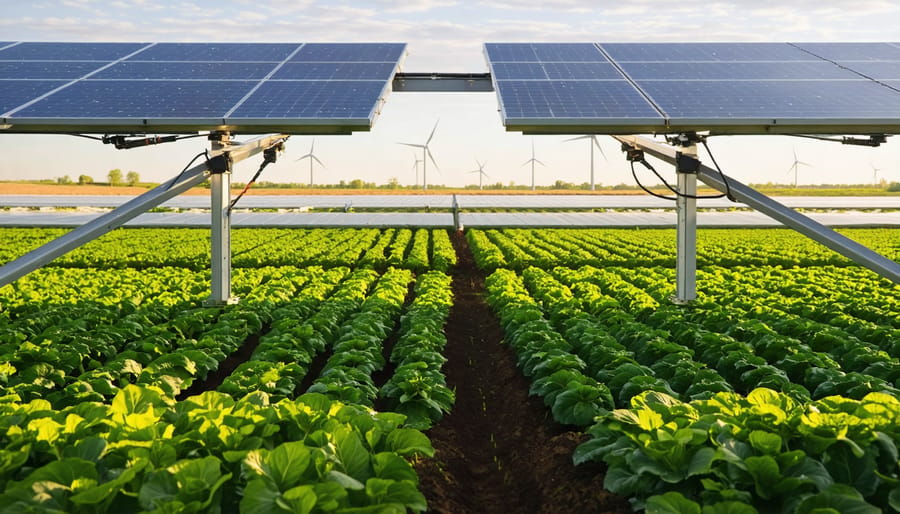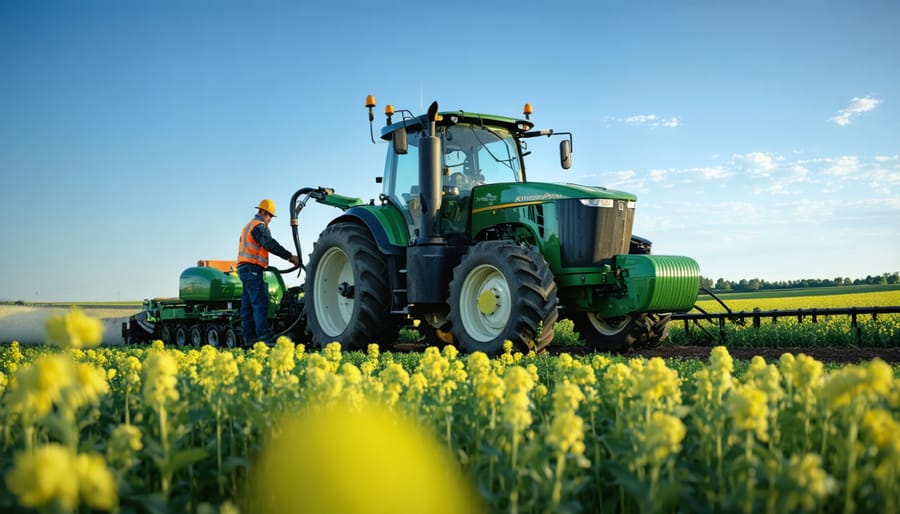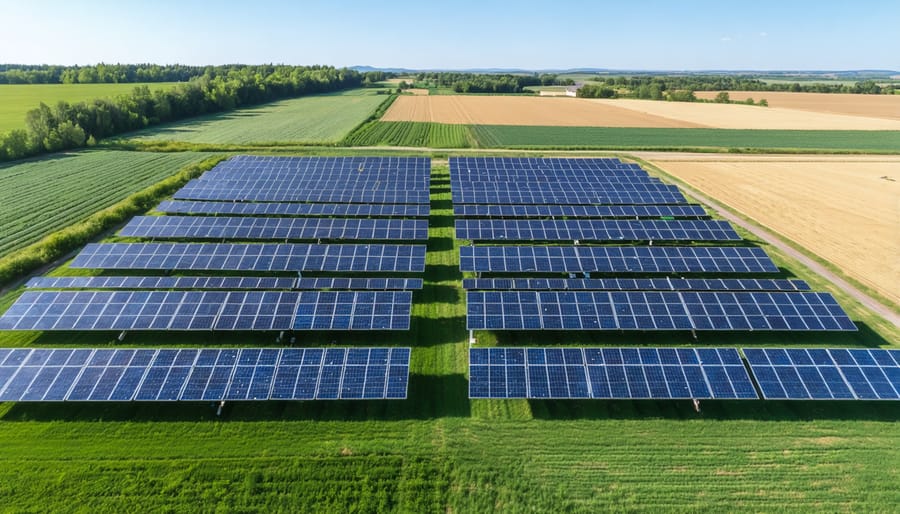Distributed energy resources (DERs) are revolutionizing how Canadian farms power their operations, offering a pathway to energy independence and sustainability. These small-scale power generation and storage systems, installed directly on agricultural properties, transform traditional power dynamics by enabling farmers to generate, store, and manage their own electricity. From solar panels on barn roofs to biodigesters converting agricultural waste into energy, DERs are becoming essential tools for modern farming operations across Alberta and beyond.
For Canadian agricultural communities, DERs represent more than just power generation – they’re a crucial step toward resilient, sustainable farming practices. By harnessing local renewable resources, farms can reduce operational costs, decrease their environmental footprint, and create new revenue streams through energy sharing programs. This decentralized approach to energy management aligns perfectly with the independent spirit of Canadian agriculture while addressing the sector’s growing need for reliable, affordable power solutions.
Whether you’re operating a small family farm in southern Alberta or managing a large-scale operation in the Prairie provinces, understanding DERs is no longer optional – it’s becoming fundamental to competitive, future-ready farming.
What Are Distributed Energy Resources?

Common Types of Agricultural DERs
Canadian farms are increasingly adopting various types of distributed energy resources to enhance sustainability and reduce operational costs. Solar power investments have become particularly popular, with rooftop installations on barns and ground-mounted systems in unused fields generating reliable power for daily operations. These systems work exceptionally well during peak summer months when irrigation demands are highest.
Wind power in agriculture has also gained traction, especially in Alberta’s wind-rich regions. Small-scale turbines can power everything from grain dryers to water pumps, providing consistent energy output during both day and night.
Biodigesters represent another valuable DER option, converting agricultural waste into usable energy. These systems are particularly effective for livestock operations, turning manure into biogas for heating and electricity generation while producing nutrient-rich fertilizer as a by-product.
Energy storage systems are becoming increasingly crucial components of agricultural DERs. Modern battery systems allow farmers to store excess energy generated during peak production periods for use during evenings or cloudy days. This capability is especially valuable during harvest season when energy demands spike.
Many Canadian farmers are combining multiple DER types to create robust hybrid systems. For example, pairing solar panels with battery storage and a biodigester can provide reliable year-round power while reducing waste and operating costs. These integrated systems often qualify for provincial and federal clean energy incentives, making them increasingly accessible to farms of all sizes.
How DERs Work on Your Farm
On your farm, DERs work as an integrated network of energy solutions that complement your existing operations. Picture your barn’s south-facing roof fitted with solar panels, capturing energy during peak daylight hours while your crops grow below. These panels can power your irrigation systems, grain dryers, and cold storage facilities, significantly reducing your reliance on grid electricity.
Many Alberta farmers have found success combining multiple DER technologies. For instance, you might pair solar installations with battery storage systems, allowing you to store excess energy generated during sunny periods for use during cloudy days or nighttime operations. This setup is particularly valuable during critical harvest periods when energy demands spike.
Your farm’s biogas potential shouldn’t be overlooked either. Livestock operations can convert manure into biogas through anaerobic digestion, providing a reliable energy source for heating and electricity generation. This system turns what was once a waste management challenge into a valuable energy resource.
Wind turbines, scaled appropriately for your property, can complement solar installations by generating power during different weather conditions and times of day. Small-scale wind projects have become increasingly popular among farmers in windy Alberta regions, particularly those with open fields away from tree lines.
The key to successful DER integration is starting small and scaling up based on your farm’s specific needs. Many farmers begin with a modest solar installation to power their workshop or irrigation system, then expand as they see the benefits. Local agricultural extension offices and renewable energy consultants can help you assess your farm’s energy needs and potential, ensuring your DER system grows alongside your operations.
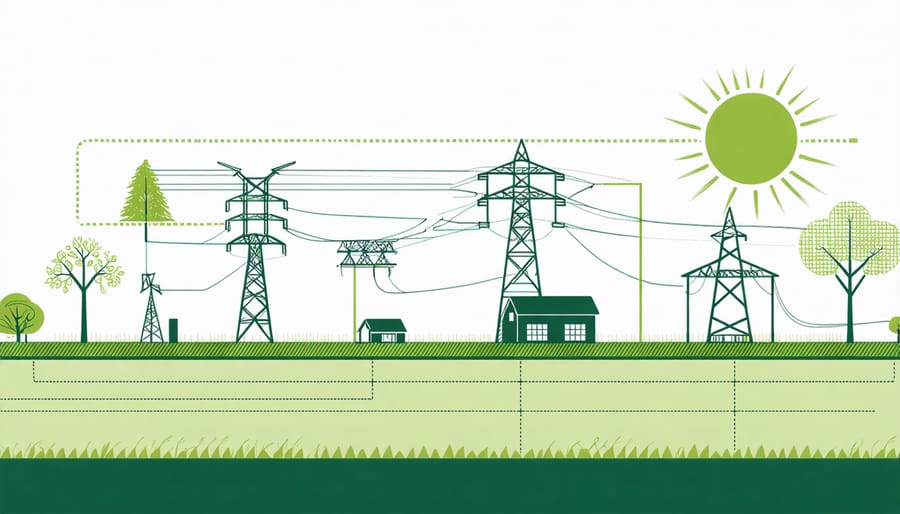
Benefits for Alberta Farmers
Energy Independence and Cost Savings
By adopting distributed energy resources, Canadian farmers can significantly reduce their dependence on traditional grid power while enjoying substantial cost savings. Many Alberta farmers have reported cutting their energy bills by 30-50% after implementing solar panels and energy storage systems on their properties.
Take the example of the Miller family farm near Lethbridge, which installed a combination of solar panels and a battery storage system in 2021. They now generate enough power to run their irrigation systems and grain drying operations during peak seasons, saving approximately $15,000 annually on electricity costs.
Beyond immediate cost reductions, distributed energy resources provide valuable protection against rising utility rates and unexpected power outages. During the 2023 winter storms, farms with their own power generation systems maintained critical operations while others faced costly disruptions.
The financial benefits extend beyond direct energy savings. Many farmers qualify for government incentives and tax benefits through programs like the Canada Greener Homes Grant and Alberta’s Energy Savings for Business Program. These initiatives can cover up to 25% of installation costs for renewable energy systems.
Additionally, excess power generated can be sold back to the grid through net metering programs, creating a new revenue stream for farm operations. Several dairy farms in central Alberta have reported earning between $2,000 and $4,000 annually from power sales, effectively turning their energy systems into income-generating assets.
Environmental Impact and Carbon Credits
Implementing distributed energy resources on your farm can significantly reduce your carbon footprint while creating new revenue opportunities through carbon credits. In Alberta, agricultural operations that adopt renewable energy systems can participate in the province’s carbon offset market, turning environmental stewardship into financial benefits.
When you integrate farm waste bioenergy systems or solar installations, you’re not just generating clean energy – you’re also contributing to Alberta’s emission reduction goals. Each megawatt-hour of renewable energy generated can offset approximately 0.65 tonnes of CO2 emissions compared to traditional grid power.
The Technology Innovation and Emissions Reduction (TIER) system in Alberta provides opportunities for farmers to earn carbon credits through verified emission reductions. These credits can be sold to larger industrial facilities that need to meet their compliance obligations, creating an additional income stream for your operation.
Many Alberta farmers have already started benefiting from this system. For example, the Smith family farm near Lethbridge generates 150 carbon credits annually through their solar installation, earning an additional $3,000-4,500 per year. Combined with energy cost savings, these environmental initiatives offer both immediate and long-term returns while supporting our province’s transition to cleaner energy solutions.
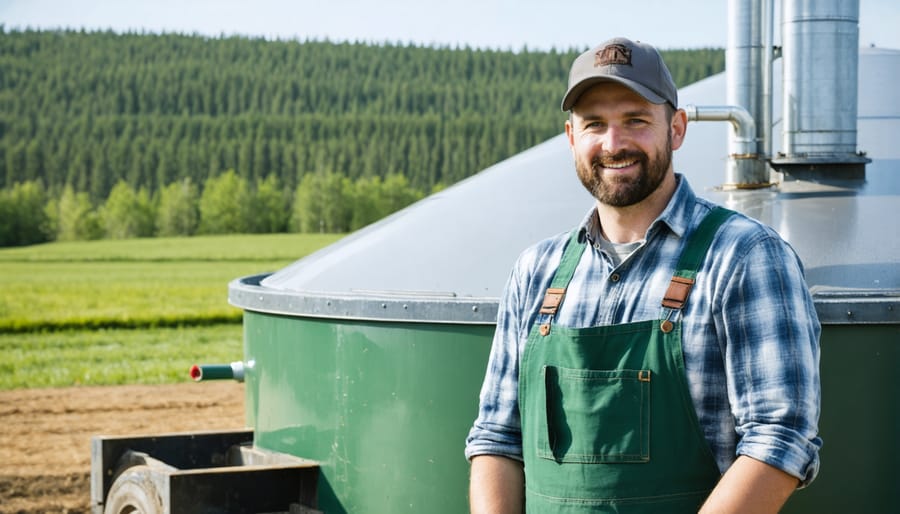
Real Success Stories: Alberta Farms Using DERs
The Schneider family farm near Stettler stands as a shining example of DER implementation in Alberta agriculture. After installing a 50 kW solar array combined with battery storage in 2019, the Schneiders have reduced their annual energy costs by 65% while maintaining reliable power for their dairy operations. “The system pays for itself, especially during peak milking times when grid electricity is most expensive,” explains Sarah Schneider, who manages the 200-hectare operation.
In Lethbridge County, the Martinez vegetable farm showcases how diversified energy systems can support year-round greenhouse operations. Their hybrid system, combining geothermal heating with solar panels, has enabled them to extend their growing season and reduce natural gas consumption by 80%. “We’re now able to grow through winter while keeping our energy costs manageable,” says Carlos Martinez, noting that the system’s reliability has been crucial during extreme weather events.
The Wilson family’s grain operation near Red Deer demonstrates how small-scale wind power can complement existing solar installations. Their 10 kW wind turbine, working alongside a 30 kW solar array, provides consistent power for grain drying and storage facilities. “Having multiple power sources means we’re never caught short during harvest,” explains Tom Wilson, who documented a 70% reduction in grid dependency since installing the hybrid system.
Perhaps most impressive is the collective approach taken by the Peace Region Agricultural Co-op, where six farms share a networked DER system. This innovative arrangement includes shared battery storage, solar installations, and a smart distribution network that allows members to exchange excess power. The co-op model has helped reduce individual installation costs by 40% while creating a more resilient local power network.
These success stories highlight how Alberta farmers are leading the way in agricultural DER adoption, proving that sustainable energy solutions can be both practical and profitable in modern farming operations.
Getting Started with DERs
Available Grants and Support Programs
Canadian farmers can access various grants and support programs to help implement distributed energy resources on their farms. The Canadian Agricultural Partnership (CAP) offers funding through its AgriInnovate program, supporting projects that enhance environmental sustainability and energy efficiency. In Alberta, the Energy Savings for Agri-Processors (ESAP) program provides up to $250,000 in funding for energy-efficient upgrades and renewable energy installations.
Alberta’s On-Farm Energy Management Program assists farmers with up to 50% of costs for energy efficiency improvements, including solar panel installations and grid interconnection equipment. The Farm Energy and Agri-Processing Program (FEAP) offers similar support for implementing clean energy solutions.
Additionally, farmers can benefit from federal tax incentives, including accelerated capital cost allowance for clean energy equipment. Local rural municipalities often provide supplementary grants and technical assistance. The Agricultural Financial Services Corporation (AFSC) offers specialized loans for sustainable agriculture projects, including distributed energy implementations.
For the most current funding opportunities, connect with your local agricultural fieldman or visit Alberta Agriculture and Forestry’s website, as programs and eligibility criteria are regularly updated.
Distributed energy resources represent a transformative opportunity for Alberta’s farming community to enhance sustainability, reduce operational costs, and contribute to a more resilient agricultural sector. By adopting these technologies, from solar panels to biogas systems, farmers can take control of their energy future while maintaining their role as stewards of the land.
Throughout this guide, we’ve explored how DERs can specifically benefit agricultural operations, from powering irrigation systems to supporting greenhouse operations. The success stories of local farmers who’ve already embraced these solutions demonstrate that the transition is not only possible but profitable.
As our agricultural sector continues to evolve, the integration of distributed energy resources will become increasingly important. We encourage you to reach out to local agricultural extension offices, connect with fellow farmers who have implemented DERs, and explore available government incentives. Together, we can build a more sustainable and energy-independent farming community in Alberta.
Remember, every step toward energy independence, no matter how small, contributes to the larger goal of creating a more sustainable and prosperous agricultural future for generations to come.



